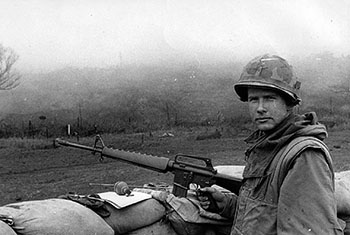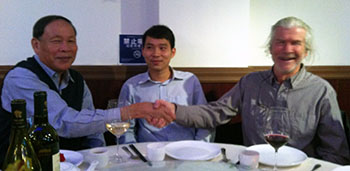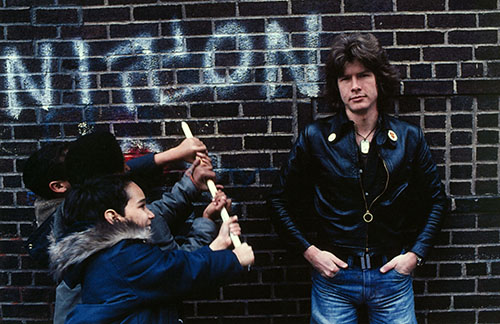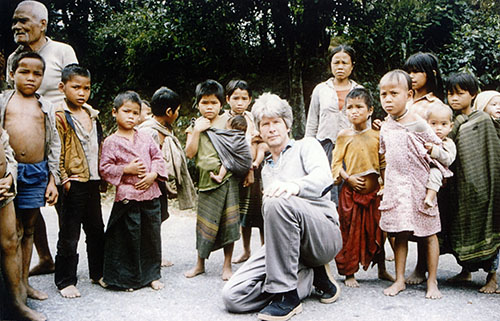 Download PDF of this full issue: v46n1.pdf (21 MB) Download PDF of this full issue: v46n1.pdf (21 MB) |
How A Swede Became a VVAW Member
By Per Odman
[Printer-Friendly Version] In the spring of 1966, 50 long years ago, I finished my ten months of compulsory service in the Swedish Army. I was born 1943 in Sweden. My father was highly educated, and very successful in his field. I, however, was pretty much the opposite—I was an immature loser, and I failed to graduate from Swedish high school. After working in mines and doing odd jobs I was ordered to enter the Army in the fall of 1965. My feelings about serving were very mixed. It turned out that I really liked it. For the first time in my life I was the best at something. I was a machine gunner, and I was my platoon commander's favorite soldier. Towards the end of my service I decided, just for the hell of it, to fight as an infantryman in Vietnam; for the US or any of its allies. If they would not take me, my not-so-realistic plan was to approach North Vietnam.

|
This 1968 photo was taken by the only
Swedish reporter/photographer who went to
Khe Sanh during the siege. After having been there
a day or so he heard rumors about a Swede.
Hisname is Bernt Nilsson and he worked
for a major daily, Aftonbladet.
|
My first step was to visit a US Army colonel who served as a military attache at the US embassy in Stockholm. He thought it was a great idea, "We need guys like you in Vietnam!" My parents thought it was a horrible idea. My father quickly got me a job as an assistant to Swedish geologists who prospected for iron ore in the wild and mountainous rain forests in Liberia in West Africa. I spent an adventurous, colonial era-like year in tropical Africa. But, in April 1967, I had gone to the US Embassy in Monrovia, the capitol of Liberia, and applied for a green card. On May 25, with a green card, I flew one way to JFK. After checking into a hotel in midtown Manhattan, I went to the recruiting station in Times Square. I talked to the Army recruiter about airborne and rangers and the Marine about a two-year enlistment. After pondering it for about one week, I swore to serve two years for the USMC. At 3am the next morning I was "welcomed" to Parris Island.
As a gung ho Marine 0311 (rifleman) I arrived in Danang on Christmas Eve 1967—what a x-mas present! A few days later I arrived to my unit, the 26th Marines, which held Khe Sanh Combat Base located near the DMZ in the northwestern corner of the I Corps, and was assigned to a rifle platoon; 2nd Platoon, Delta Company, 1st Battalion. They called me "Swede." On January 20, 1968, the siege began. It is true that I was a gung ho Marine, but I was not really fighting for the US; I was fighting for myself and my platoon. The killings on both sides during the siege made me quite aware of how ambivalent I was about the US trying to win the war. After a very tough 77 days, the siege was officially over. MACV declared an overwhelming victory, but the battle casualties are controversial. We lost maybe as many as 1,000 KIA, the NVA as many as 10,000.
The commander of one of the NVA's dozens of well dug in and camouflaged batteries that encircled and fired thousands of high explosive shells on us was 27-year-old Captain Nguyen Van Rinh. However, our enormous firepower, from 105s to B-52s, slowly but surely eliminated most of the howitzers and rocket launchers. Captain Rinh survived this hellish bombardment. And he kept on fighting the Americans and then the ARVNs, and on April 30, 1975 he and his comrades celebrated their victory. And so did we, Vietnam Veterans Against the War.
After the siege my battalion did sweeps in depopulated areas in the central parts of I Corps. We were after the NVA, and they were after us. On June 7, NVA Major Cao Kai ordered his soldiers to set up ambushes. I know his name because I met him in 1994 where the ambushes had been set. They were successful. My platoon walked into one of them. I was hit by AK47 bullets, which somehow had lost some of their velocity (not due to my flak jacket—I had thrown it away), in my left lung and my neck. The bullets lodged in the lung and in the rear of my neck. The bullet that hit my neck entered from the front and tore partially apart my right jugular vein. A third bullet shattered as it hit something hard, like the muzzle of my M16. Ten pieces (you can count them on a cat-scan) of this bullet hit my left temple with the force of a heaved sledge hammer. The force of the hit tore a hole in my skull bone the size of a silver dollar. The pieces of bone were lodged in the outer part of my brain. The ten pieces of the bullet lodged one to two inches deep in my brain, and one in the center of my brain. I was conscious long enough to instinctively know that I was dying.
Who saved my life? Our corpsman? A Marine? I met my platoon commander 25 years later, for the first time since the incident: "Are you fucking alive?!" The medevac helicopters were on their way to pick up the wounded, but when he saw me laying next to the KIAs with an ashen face and covered in blood he knew I was dead. Due to attrition he became our company commander the following day, and lost track of his men. What really saved me was somebody's decision to haul me on board that chopper.
Initially my right side was completely paralyzed, but to make a long story short, two and a half months later I was back in Sweden running cross-country—slowly. The Marines rated me 90% disabled and retired me in May 1969. The VA rated me 100% disabled. I decided to study architecture in Washington, DC, but after a couple of years I moved to New York to study photography. On the surface my life in Washington had seemed normal—I made friends and had girlfriends, but my move to New York in 1971 immediately exposed me to a totally new world—a radical anti-war world that I embraced. It made me wake up from my emotional and political torpor. I joined Vietnam Veterans Against the War, partook in their rap groups, and at VVAW's demonstrations I vented my hatred of the war. I was a "reborn" Marxist.

|
Mr. Nguyen Van Rinh (president of VAVA and
former Senior Lieutenant General of the NVA)
shakes hands with Per Odman (former Marine who
served in Vietnam). Rinh and Odman fought on
opposite sides at siege of Khe Sanh in 1967.
|
During the nineties I revisited Vietnam four times—to see the country and the people. On each trip I went to Hanoi to meet my former enemies. We drank a lot of beer, ate a lot of weird food and with the help of an interpreter told each other war stories. In April 1994, partly for adventure and partly for reconciliation, I did a four-day-long climb of Fan Si Pan, at 10,312 feet Vietnam's tallest mountain, together with Nguyen Thien Hung, my guide. After the two first hours of steadily climbing on day one, Hung and I took a break. By using pencil and paper, gestures and facial expressions, and uttering sounds I found out that Hung had been fighting the Americans since 1967. He had been fighting us all through the war. As a 2nd Lieutenant, and a tank commander Hung had taken part in the final route of the ARVN and on April 30, 1975 had victoriously driven his tank into Saigon. In 1983 Hung had left the People's Army and moved back home to the mountainous north western corner of Vietnam. My climb turned out to be more of a reconciliation than I had thought. Two of the nights we lay huddled against each other for body heat, belly against rump. Our damp wool blanket barely cut the freeze.
Last December, I had the great pleasure of meeting one more of my former enemies, here in New York City. Captain Nguyen Van Rinh, the battery commander who survived Khe Sanh, made his career in the People's Army. He retired as a Colonel General, the second highest rank in the People's Army, and continued his service for Vietnam as Deputy Minister of Defense. He is nowadays President of VAVA (see Susan Schnall's article on page 1). We heartily shared a meal in a Chinese restaurant in Midtown. With the help of his interpreter we warmly shared some of our experiences of trying to kill each other.
Per-Olof Odman has worked as a photographer, but most of his life he has, with his own hands, renovated old houses. At present, one in France.

|
1973 photo of Per with Puerto Rican kids. He is wearing two VVAW buttons on his collar.
The photo was taken by a professional Swedish photographer — Hasse Persson for a major Swedish magazine.
|

|
|
Per near Khe Sanh in 1992.
|
|






